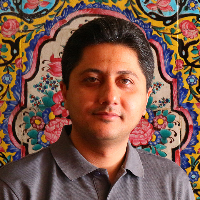The Courtyard landscape changes of Karim Khan Citadel (Arg) in Shiraz based on Historical Photos & Documents
Author(s):
Article Type:
Research/Original Article (دارای رتبه معتبر)
Abstract:
Karim Khan's Citadel (Arg) is the largest brick building in the Zandieh Complex in Shiraz, built with his ideas & desires. Its courtyard landscape has evolved throughout history, which is inconsistent with the current situation. Reading its landscape changes can pave the way for a proper restoration program and refine its current understanding of the citadel architecture and its spatial-visual character. The purpose of this study is to read the developments of the citadel courtyard landscape in two parts: a) landscaping features ('planting plan', 'water order' and 'geometry of parterres') and b) elements of architectural interventions adjoining from Zand era to contemporary time. The method of research is 'historical-interpretive'. Research documents include (a) travelogues, historical documents and books, (b) historical photos from the Qajar era, (c) aerial imagery, and (d) field observations. The readings of historical photos are done using single-point and two-point perspective principles, and the resulting data was supported by overlaps. The findings showed that the developments of the citadel landscape could be categorized into four periods: 'Formation (Zand)', 'Transformation & Changes (Qajar)', 'De-functionalizing and Demolition (Pahlavi)' and 'Restoration & Rehabilitation (Islamic Republic)'. The courtyard's original landscape has been transformed from 'Garden of the Residency' to 'Yard Garden' of the Late Qajar, 'Court of the Prisoner' of the Pahlavi era, and finally 'Orangery' in the present time. The original planting plan consisted of tall trees (plane and cypress) and short tress (citrus and orange) and flowers arranged in three lower, middle and upper eye levels. The water-supply order in the center, including pools and fountains, has more or less maintained its structure. However, the layouts of parterres have changed due to both physical and non-physical intervention subjects. The aesthetics of the Zand dynasty have remained in the courtyard landscape until the days of Mozaffar al-Din Shah (about 140 years), and since then their visual character has been transformed and confined to the lower and middle visual eye levels.
Keywords:
Citadel , planting plan , Landscape , garden , Zand dynasty
Language:
Persian
Published:
Iranian Archaeological Research Journal, Volume:10 Issue: 25, 2020
Pages:
241 to 260
magiran.com/p2181324
دانلود و مطالعه متن این مقاله با یکی از روشهای زیر امکان پذیر است:
اشتراک شخصی
با عضویت و پرداخت آنلاین حق اشتراک یکساله به مبلغ 1,390,000ريال میتوانید 70 عنوان مطلب دانلود کنید!
اشتراک سازمانی
به کتابخانه دانشگاه یا محل کار خود پیشنهاد کنید تا اشتراک سازمانی این پایگاه را برای دسترسی نامحدود همه کاربران به متن مطالب تهیه نمایند!
توجه!
- حق عضویت دریافتی صرف حمایت از نشریات عضو و نگهداری، تکمیل و توسعه مگیران میشود.
- پرداخت حق اشتراک و دانلود مقالات اجازه بازنشر آن در سایر رسانههای چاپی و دیجیتال را به کاربر نمیدهد.
In order to view content subscription is required
Personal subscription
Subscribe magiran.com for 70 € euros via PayPal and download 70 articles during a year.
Organization subscription
Please contact us to subscribe your university or library for unlimited access!



